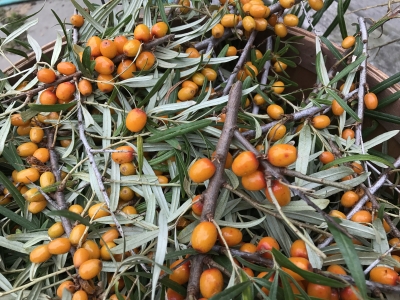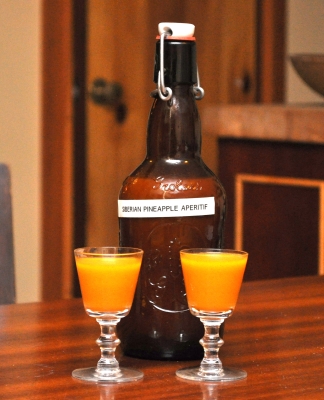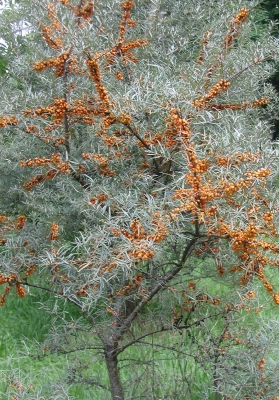The Bad and the Good
Winecaps, Not For Me
My successes with growing shiitake mushrooms emboldened me, this past spring, to venture further afield, to wine cap mushrooms (Stropharia rugosoannulata). After all, it’s been billed as “prized, delicious” and “edible when young.”
Their quick production also prompted me to give them a try. As a matter of fact, my spring “planting” started bearing a couple of weeks ago. A bed can also be refreshed or a new bed can be inoculated from an old bed for repeat performances.
Let’s go back to spring, to my planting. Wine caps grow very well in wood chip mulch, something that’s aplenty on my farmden. My berry bushes are mulched, my pear trees are mulched, as are the paths in my vegetable gardens. Why not do double duty with those mulches?
A few years ago, I attempted just that, laying a thick mulch of chips atop my asparagus bed in spring. Two problems: The thick mulch almost killed the plants, and the weather was very dry for weeks on end. Mushrooms need moisture.
This past spring, I pulled back twigs and other debris from a patch of ground beneath a Norway spruce tree and laid down a few inches of hardwood chip mulch. After sprinkling the purchased spawn over the mulch, I topped everything with another inch or two of, this time, wood shavings.
For this spring’s planting, I also decided to water, so set up a sprinkler. Rain fell pretty consistently all season long, obviating the need for further watering.
The tasting: To me, the mushrooms were tasteless. Sure, I could have sautéed them with butter and garlic; then they would have tasted like butter and garlic. (Disclaimer: Your results may differ from mine.)
My taste for wine cap mushrooms went down another notch when I more recently read a caution to eat them moderately and not more than two days in a row. My yard abounds with plenty of other good tasting, healthful food, so I’ll pass on the wine caps.
Seaberries For Me
On to more tasty items. Seaberries (Hippophae rhamnoides). The harvest is in, the first harvest from my 2013 planting. I wanted them for juice and, on the recommendation of seaberry expert Jim Gilbert of www.onegreenworld.com, planted Titan, Leikora, and Orange Energy.
Seaberry plants are either male or female. Only female plants bear fruit; to do so, they need pollen from a nearby male, which I also planted. One male can sire up to 8 females.

Seaberry, Titan
In addition to yielding very healthful berries, seaberries further earn their keep as landscape plants. (I’ve seen them planted as ornamentals in New York City’s Battery Park.) The bush’s thin, olive green leaves are the perfect backdrop for the bright orange berries, clustered thickly right along the stems.
And there’s the rub. Long, sharp thorns also cluster along the stems, making harvest a potentially painful proposition.
I used the method Jim recommended for harvest, and that is to cut stems heavily laden with berries into 6 inch long pieces, put them into a covered plastic tub, and then freeze them. The frozen berries came off the stems when the tub was shaken vigorously. All I had to do then was to pick out the stems, and then winnow the leaves from the fruit in front of a fan.
The berries are now back in the freezer, to be made into juice at my leisure. That’ll involve cooking them in a little water, mashing them with a potato masher, and then straining. My previous planting yielded a delicious juice once diluted with 1/8 part water and sweetened with 1/8 part maple syrup or honey.
This season’s juice should be even better because the berries taste better than the previous varieties I planted. Especially good — even straight from the bush — in the new planting is the variety Titan. Seaberry generally tastes, to me, like very rich orange juice with the addition of pineapple or passionfruit. Titan has more of a tangerine-y flavor.
Permaculture-esque
Wine cap mushrooms and seaberries are both plants beloved by permaculturalists. The mushrooms for the little care they need, and their use of mulched ground. The seaberries, also for their low maintenance, their beauty, and their enrichment of the soil with nitrogen.

Seaberry bush
My seaberries are in a permaculturalesque planting, along with elderberry, highbush cranberry, nannyberry viburnum, rugose rose, Korean pine, and aronia. They’re all easy to care for. They’re all very ornamental. The only ones that taste good or yield anything are the seaberry and the rugosa roses.


Which variety of viburnum do you grow? We are surrounded by woods, and would love to hear what you recommend for planting on the edges of the woodland.
Cranberry bush is very pretty in flower in spring, and then in fruit from late summer on. Some people make jelly out of the fruit but I leave them for the birds. I aso like nannyberry viburnum. And a few viburnums are super fragrant; the one I grow is Koreanspice viburnum.
Thanks so much for your reply! I will look into the varieties you mentioned.
live in Cody, WY- zone 4/5. This sounds like the perfect bush to plant where I need a thorn hedge to keep out unwanted visitors to my garden from the back alley way- both dear and deer. I was thinking pyracantha, but this is much better. Do you have any idea where I could locate two of these (male and female?
Check out http://www.raintreenursery.com. You can link to it via its ad in the lower part of this blog page.
Thanks for the post on seaberries. Totally solidify my decision to get them. Now I just got to figure where to put them.